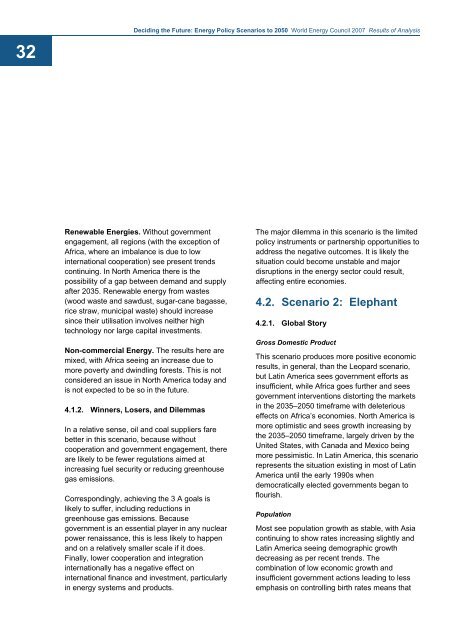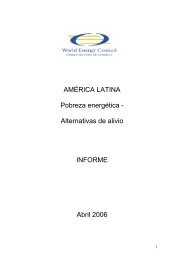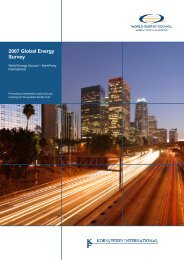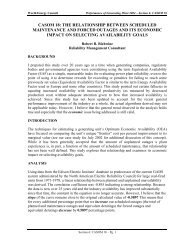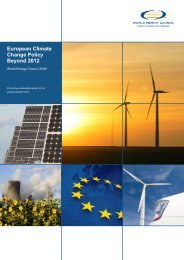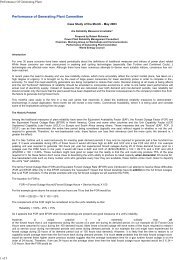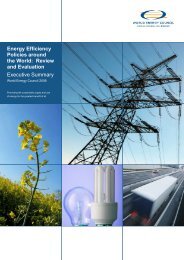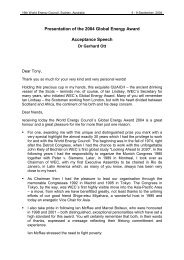Deciding the Future: Energy Policy Scenarios to 2050
Deciding the Future: Energy Policy Scenarios to 2050
Deciding the Future: Energy Policy Scenarios to 2050
Create successful ePaper yourself
Turn your PDF publications into a flip-book with our unique Google optimized e-Paper software.
32<br />
<strong>Deciding</strong> <strong>the</strong> <strong>Future</strong>: <strong>Energy</strong> <strong>Policy</strong> <strong>Scenarios</strong> <strong>to</strong> <strong>2050</strong> World <strong>Energy</strong> Council 2007 Results of Analysis<br />
Renewable Energies. Without government<br />
engagement, all regions (with <strong>the</strong> exception of<br />
Africa, where an imbalance is due <strong>to</strong> low<br />
international cooperation) see present trends<br />
continuing. In North America <strong>the</strong>re is <strong>the</strong><br />
possibility of a gap between demand and supply<br />
after 2035. Renewable energy from wastes<br />
(wood waste and sawdust, sugar-cane bagasse,<br />
rice straw, municipal waste) should increase<br />
since <strong>the</strong>ir utilisation involves nei<strong>the</strong>r high<br />
technology nor large capital investments.<br />
Non-commercial <strong>Energy</strong>. The results here are<br />
mixed, with Africa seeing an increase due <strong>to</strong><br />
more poverty and dwindling forests. This is not<br />
considered an issue in North America <strong>to</strong>day and<br />
is not expected <strong>to</strong> be so in <strong>the</strong> future.<br />
4.1.2. Winners, Losers, and Dilemmas<br />
In a relative sense, oil and coal suppliers fare<br />
better in this scenario, because without<br />
cooperation and government engagement, <strong>the</strong>re<br />
are likely <strong>to</strong> be fewer regulations aimed at<br />
increasing fuel security or reducing greenhouse<br />
gas emissions.<br />
Correspondingly, achieving <strong>the</strong> 3 A goals is<br />
likely <strong>to</strong> suffer, including reductions in<br />
greenhouse gas emissions. Because<br />
government is an essential player in any nuclear<br />
power renaissance, this is less likely <strong>to</strong> happen<br />
and on a relatively smaller scale if it does.<br />
Finally, lower cooperation and integration<br />
internationally has a negative effect on<br />
international finance and investment, particularly<br />
in energy systems and products.<br />
The major dilemma in this scenario is <strong>the</strong> limited<br />
policy instruments or partnership opportunities <strong>to</strong><br />
address <strong>the</strong> negative outcomes. It is likely <strong>the</strong><br />
situation could become unstable and major<br />
disruptions in <strong>the</strong> energy sec<strong>to</strong>r could result,<br />
affecting entire economies.<br />
4.2. Scenario 2: Elephant<br />
4.2.1. Global S<strong>to</strong>ry<br />
Gross Domestic Product<br />
This scenario produces more positive economic<br />
results, in general, than <strong>the</strong> Leopard scenario,<br />
but Latin America sees government efforts as<br />
insufficient, while Africa goes fur<strong>the</strong>r and sees<br />
government interventions dis<strong>to</strong>rting <strong>the</strong> markets<br />
in <strong>the</strong> 2035–<strong>2050</strong> timeframe with deleterious<br />
effects on Africa’s economies. North America is<br />
more optimistic and sees growth increasing by<br />
<strong>the</strong> 2035–<strong>2050</strong> timeframe, largely driven by <strong>the</strong><br />
United States, with Canada and Mexico being<br />
more pessimistic. In Latin America, this scenario<br />
represents <strong>the</strong> situation existing in most of Latin<br />
America until <strong>the</strong> early 1990s when<br />
democratically elected governments began <strong>to</strong><br />
flourish.<br />
Population<br />
Most see population growth as stable, with Asia<br />
continuing <strong>to</strong> show rates increasing slightly and<br />
Latin America seeing demographic growth<br />
decreasing as per recent trends. The<br />
combination of low economic growth and<br />
insufficient government actions leading <strong>to</strong> less<br />
emphasis on controlling birth rates means that


